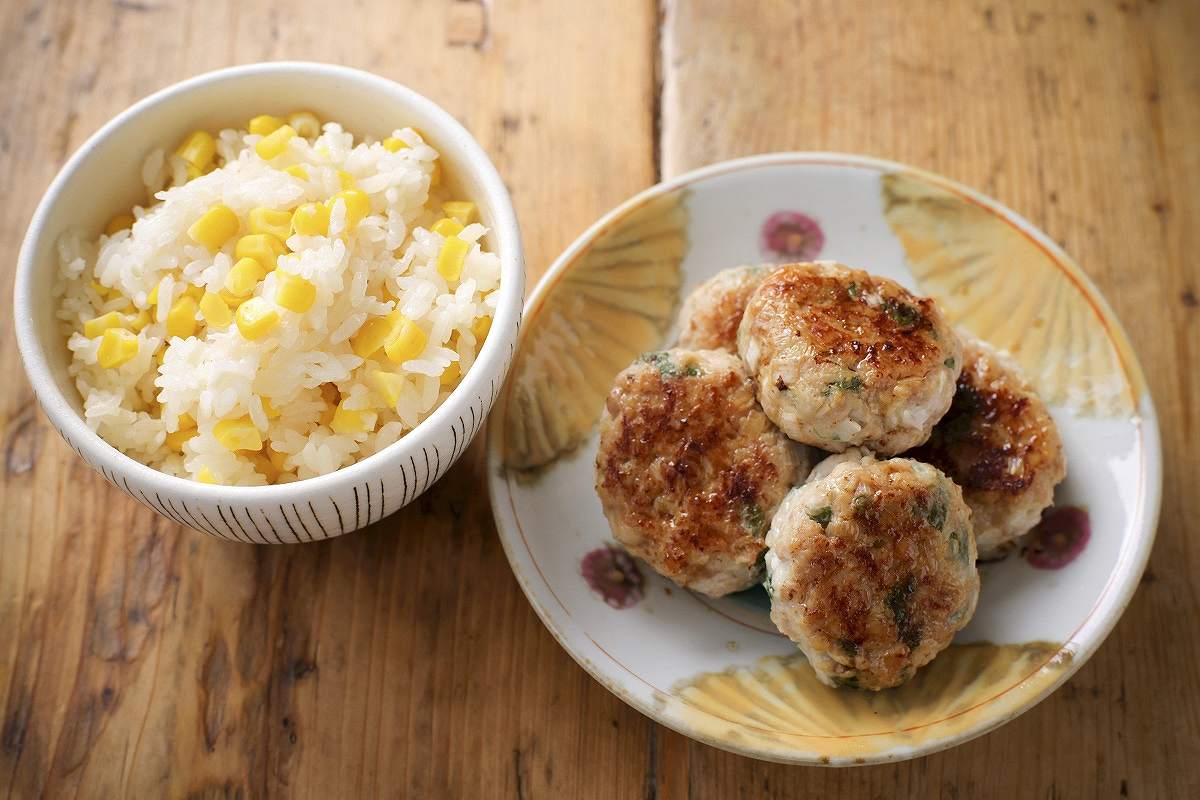
A bowl of shio-koji corn rice and a plate of shio-koji tsukune meat balls with shiso leaves
12:30 JST, October 1, 2023
With the turning of the seasons, now is a good time to eat fermented food that improves stomach health. Cooking specialist Misa Enomoto, a master of fermented food, spoke with The Yomiuri Shimbun about dishes incorporating shio-koji, or salted rice malt.
Shio-koji is a seasoning made by fermenting a mixture of rice malt, salt and water. I’m 49, but it was only about 10 years ago that I first learned about the seasoning. At that time, there was a sort of boom for shio-koji, and magazines and cookbooks often carried instructions on how to make it. I used them as reference and tried my hand at making the seasoning. To my utter surprise, I ended up making a large quantity. Although I kept it in a refrigerator and used it for cooking, most of the shio-koji went bad before I could use it all.
Around that time, food manufacturers put out various shio-koji products one after another. Now shoppers can easily get their hands on reasonable amounts of the seasoning in bottles and plastic packages at supermarkets. Local eateries and chain restaurants also often offer dishes using it. Shio-koji has become a fixture in seasonings.
At my household, however, the debacle I had is still having a lasting effect, and my 12-year-old son says, “Oh, that thing that went bad in the fridge,” whenever he hears the word shio-koji. At the time, he was still very young and a handful, so I had little time to be creative with cooking. And so, I wondered, “Could I make good use of shio-koji now?”
“Substituting shio-koji for salt adds a mild salty taste, sweetness and depth to a dish. You can make it delicious even without using other condiments. It’s a very useful seasoning,” Enomoto said.
She taught me how to cook shio-koji corn rice, which is rice cooked with shio-koji and corn kernels. The slightly salty and sweet taste enhances the corn’s inherent flavor.
“By adding shio-koji, the rice gains a soft and glutenous texture when cooked, and it tastes good even after going cold. Try adding [shio-koji] to the rice when you cook it in the usual way,” Enomoto said.
I had never known you could add shio-koji to rice when you cook it.
Shio-koji corn rice
Ingredients:
- 2 cups rice (1 cup = 180 milliliters)
- 1 corn cob
- 1 dried kombu sheet (5 cm x 5 cm)
- 2 tbsp shio-koji
- 1 tbsp sake
- ½ negi leek
- 300 grams minced chicken
- 4 tsp shio-koji
- 5 green shiso leaves
- 1 tsp oil
Directions:
1. Wash rice with water and drain. Put the rice and 1 tablespoon of sake in a rice cooker, then pour water up to the line for 2 cups of rice inside the inner pot of the rice cooker. Make small cuts to the kombu piece and place it on top of the water. Let the mixture stand for 30 minutes.
2. Cut the corn cob in two. Stand each section on a cutting board and scrape off the kernels with a knife. Do not throw away the cores.
3. Add shio-koji to the rice cooker, stir gently, put the corn cores on top and cook the rice.
4. Once the rice is cooked, let it stand for 10 minutes. Then remove the corn cores and the kombu piece before mixing well.
Shio-koji can soften meat and fish as well. Shiso tsukune (chicken meat balls with shiso leaves) is a dish that makes the most of this ability. The tsukune balls have a soft texture and a nicely complex taste.
Shiso tsukune
Ingredients (2 to 3 servings):
Directions:
1. Finely chop the negi leek.
2. Put the minced chicken, chopped negi leek and shio-koji in a bowl. Add hand-torn green shiso leaves and lightly mix everything.
3. Divide the mixture into eight pieces and shape each piece into an oval. Put oil in a frying pan and, over medium heat, fry the meat balls on each side for 1½ minutes. Then, cover the pan with a lid and heat further on low heat.
As I put both dishes on the dinner table I told my son, “I seasoned them with shio-koji.” He did not seem to care and just heartily ate the dishes without saying anything. It looks like it satisfied his appetite.
I wonder if I’ll try my hand at making shio-koji again. I guess this time I can finish using it up.
"Features" POPULAR ARTICLE
-

Sanrio to Open Museum in Yamanashi Pref. Dedicated to Founder, Exhibits Include Hello Kitty, Other Characters
-

Autumn Foliage Surrounds Visitors to Tokyo’s Showa Kinen Park
-

My Daughter No Longer Speaks to Me, But I Want to See Her and My Grandchild
-

Kumamoto: Public Bath Refurbished as Library Where You Can Chat, Take Photos
-

Frozen Vegetables: Demand Rises for Convenient, Tasty Domestic Produce
JN ACCESS RANKING
-

Keidanren Chairman Yoshinobu Tsutsui Visits Kashiwazaki-Kariwa Nuclear Power Plant; Inspects New Emergency Safety System
-

Imports of Rare Earths from China Facing Delays, May Be Caused by Deterioration of Japan-China Relations
-

University of Tokyo Professor Discusses Japanese Economic Security in Interview Ahead of Forum
-

Japan Pulls out of Vietnam Nuclear Project, Complicating Hanoi’s Power Plans
-

Govt Aims to Expand NISA Program Lineup, Abolish Age Restriction




















